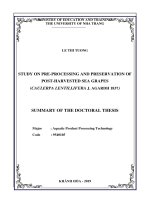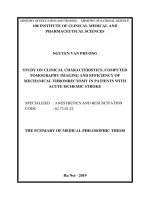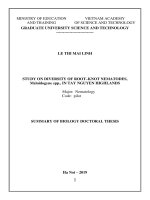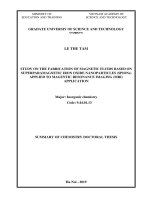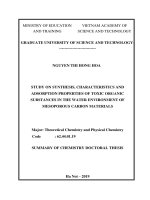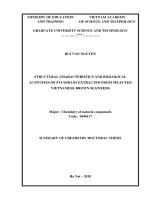Summary of Chemistry Doctoral thesis: Study on chemical constituents and biological activities from Culcita Novaeguineae Müller & Troschel, 1842 and Pentaceraster Gracilis (Lutken, 1871) in
Bạn đang xem bản rút gọn của tài liệu. Xem và tải ngay bản đầy đủ của tài liệu tại đây (1.81 MB, 28 trang )
1
MINISTRY OF EDUCATION
VIETNAM ACADEMY
AND TRAINING
OF SCIENCE AND TECHNOLOGY
GRADUATE UNIVERSITY SCIENCE AND TECHNOLOGY
----------------------------
Bui Thi Ngoan
STUDY ON CHEMICAL CONSTITUENTS
AND BIOLOGICAL ACTIVITIES FROM
CULCITA NOVAEGUINEAE MÜLLER &
TROSCHEL, 1842 AND PENTACERASTER
GRACILIS (LUTKEN, 1871) IN VIETNAM
Major: Organic chemistry
Code: 62.44.01.14
SUMMARY OF CHEMISTRY DOCTORAL THESIS
Hanoi - 2018
1
This thesis was completed at: Graduate University Science and
Technology - Vietnam Academy of Science and Technology
Adviser 1: Prof. Dr. Chau Van Minh
Adviser 2: Dr. Nguyen Hoai Nam
1st Reviewer:.................................................................
2nd Reviewer:................................................................
3rd Reviewer:.................................................................
The thesis will be defended at Graduate University of Science and
Technology - Vietnam Academy of Science and Technology, at
hour
date
month
2018.
Thesis can be found in:
- The library of the Graduate University of Science and Technology,
Vietnam Academy of Science and Technology
- National Library
2
INTRODUCTION
1. The urgency of the thesis
The starfish are invertebrates belonging to the class
Asteroidea, phylum Echinodermata. Following the classification of
Blacke (1987), the class Asteroidea including Brisingida,
Forcipulatida, Notomyotida, Paxillosida, Spinulosida, Valvatida, and
Velatida. From the 1997 to 2007, the aproximately 98 starfish species
were investigated on the chemical conponents as the report of Guang
Dong et al. The secondary metabolites from the starfish are
characterized by a diversity of polar steroids, including
polyhydroxylated steroids and steroid glycosides. There are two main
structural groups of steroid glycosides from the starfish, namely
asterosaponins and glycosylated polyhydroxysteroids. Those
compounds showed several biological properties, such as cytotoxic,
hemolytic, and anti-microbial effects.
In the Vietnam sea, the starfish belong to the phylum
Echinodermata, which was known as the 350 species of 58 phylums,
and are divided into five classes Holothuroidea (sea cucumbers),
Asteroidea (starfishes), Echinoidea (sea urchins and sand dollars),
Crinoidea (crinoids and sea lilies), and Ophiuroidea (brittle stars and
basket stars). Up to date, the chemical constituents and biological
acivities of 9 starfish species abundant in the Vietnam sea were
studied, including Archaster typicus, Asterina batheri, Asteropsis
carinifera, Astropecten polyacanthus, Astropecten monacanthus,
Protoreaster nodosus, Acanthaster planci, Linckia laevigata, and
Anthenea aspera. Their structures were determined as the steroid and
steroid glycoside which displayed the cytotoxic activity and antiinlammatory.
3
In this study, the chemical components and biological
activities of two starfish C. novaeguineae and P. gracilis in Vietnam
were identified. The results will be contributed in the medicinal and
pharmaceutical industry as an important role for the discovery and
development of new drugs. Therefore, thesis title was chosen to be:
“Study on chemical constituents and biological activities from
Culcita novaeguineae Müller & Troschel, 1842 and Pentaceraster
gracilis (Lutken, 1871) in Vietnam”.
2. The objectives of the thesis
Investigated on the chemical constituents of the two starfish C.
novaeguinea and P. gracilis in the East-North sea of Vietnam.
Studied on the cytotoxic activity of the isolated compounds to
find the bioactive compounds.
3. The main contents of the thesis
The extraction and isolation of compounds from the starfishes C.
novaeguineae and P. gracilis in Viet Nam using the chromatography
methods.
The structure determination of the isolated compounds based
on the physical and chemical methods.
Studied the cytotoxic activity of the isolated compounds.
CHAPTER 1. OVERVIEW
Overview of internal and international researches related to
our study.
1.1 The previous studies in the world about the chemical
constituents and biologycal activities from the starfishes.
Numerous studies on the chemical components of the starfish
in the world were reported. The steroid, glycoside (glycoside of
polyhydroxysteroid, asterosaponin and cyclic steroid glycoside...)
4
were the main groups with the cytotoxic, antibacteria, and antiinflammatory activities.
1.2 The previous studies about the chemical constituents and
biologycal activity from the starfish in Vietnam.
Up to date, the several starfishes were investigated the
chemical constituents from the Vietnam sea, including Archaster
typicus, Asterina batheri, Asteropsis carinifera, Astropecten
polyacanthus, Astropecten monacanthus, Protoreaster nodosus,
Acanthaster planci, Linckia laevigata, and Anthenea aspera. The
steroides,
glycosides,
including
the
glycoside
of
polyhydroxysteroides, asterosaponin were evaluated with their
cytotoxic and anti-inflammatory activities.
CHAPTER 2. EXPERIMENT AND RESULTS
2.1. Materials
2.1.1. The starfish Culcita novaeguineae
The starfish C. novaeguineae was collected at Quang Ninh,
Vietnam, in October 2013, and identified by Prof. Do Cong Thung.
2.1.2. The starfish Pentaceraster gracilis
The starfish P. gracilis was collected at Bac Van, Co To,
Quang Ninh, Vietnam, in March 2014, and identified by Prof. Do
Cong Thung.
2.2. Methods
2.2.1. The extraction and isolation of compounds methods
The combination of the chromatography methods including thin
layer chromatography (TLC), the preparative of thin lay
chromatography, and the column chromatography (CC).
5
2.2.2. The structure determination of isolated compound methods.
The structure identification is the combination of the physical
properties and the model spectroscopic methods, including the
Electrospray Ionisation Mass Spectrometry (ESI-MS), the Highresolution electrospray ionisation mass spectrometry (ESI-MS), []D,
and Nuclear magnetic resonance spectroscopy (NMR).
2.2.3. The cytotoxic activity assay.
The cytotoxic activity of the isolated compounds was
evaluated by SRB method.
2.3. Extraction and isolation of compounds
2.3.1. The extraction and isolation of compounds from Culcita
novaeguineae
This part showed the extraction and isolation experiments of
the compounds isolated from the starfish C. novaeguineae.
CH2CL2
(15,2 g)
MPLC SNAP-Sil
C1
DM 100:1 – 1:1
C4
C8 (2 g)
C7
C9
CC, YMC RP-18 MW 1:1 – 5:1
C8.1
C8.2
(500 mg)
C8.3
(387mg)
C8.4
(172 mg)
CC, Silicagel EMW 10/1/0,1
C8.5A,B
C8.5C
(46mg
C8.5D
(18mg)
C8.5E
(76mg)
C8.5F
(150mg)
Silica gel CC
D/M/W 5/1/0,1
YMC CC
M/W 1,5/1
CN9
(5,4 mg)
C8.6
(185 mg)
C8.5
(560 mg)
Silica gel CC
E/M/W
10/1/0,1
Sephadex LH-20
M/W 2/1
H8.5F1
CN3
(4,0mg)
CN4
(7,5mg)
C8.5G
(150mg)
H8.5F2
YMC CC
A/W 1/1
CN5
(9,5mg)
CN8
(3,5mg)
CN6
(2,5mg)
CN7
(5,0mg)
Figure 2.4-6. The extraction and isolation of compounds isolated from the
water layer of C. novaeguineae
2.3.2. Extraction and isolation of compounds from P. gracilis
This part showed the extraction and isolation experiments of
compounds from the starfish P. gracilis
6
W3
8.5 g
YMC CC, MW: 1/1
W3 A
2.7 g
W3B
700 mg
W3B1
50 mg
W3B2
80 mg
W3D
1.3 g
W3C
720 mg
DMWa:
2.5/1/0.15/0.002
DMWa:
2.7/1/0.15/0.002
W3C1
220 mg
W3E
900 mg
DMW:
4/1/0.15
DMWa:
2.5/1/0.15/0.002
W3D1
210 mg
W3D2
700 mg
Sephadex
MW: 1/1
Sephadex
MW: 1/1
W3D2a
240 mg
PG2
12 mg
EMW:
1.8/1/0.2
W3D2a1
60 mg
W3D2a2
40 mg
W3E1
80 mg
Sephadex
MW: 1/1
W3E1a
50 mg
DAW:
1/2/0.1
PG7
18 mg
MW: 1.5/1
W3D2a2a
25 mg
W3E2
120 mg
W3E3
60 mg
Sephadex
MW: 1/1
W3E2a
80 mg
W3E3a
25 mg
Sephadex
MW: 1/1
PG4
10 mg
W3E4
100 mg
EMW:
5/1/0.1
W3E5
65 mg
DAW:
1/3/0.1
W3E3b
10 mg
Sephadex
MW: 2/1
PG6
8 mg
EMW:
3.5/1/0.1
PG5
25 mg
W3E5a
23 mg
MW: 2.5/1
PG3
10 mg
EMW:
2.5/1/0.15
PG1
9 mg
Figure 2.7-9. Extraction and isolation of compounds isolated from P.
gracilis
2.4. Physical properties and spectroscopic data of the isolated
compounds from C. novaeguineae and P. gracilis
2.4.1. Compound CN1: Novaeguinoside E (New compound)
White powder, HR-ESI-MS m/z 1273,5257 [M + Na]+,
Molecular formula C56H91NaO27S. 1H-NMR (DMSO-d6, 500 MHz)
and 13C-NMR (DMSO-d6, 125 MHz) (see Table IV.1.1).
2.4.2. Compound CN2: Natri 6α-[(O-β-D-fucopyranosyl-(l2)-O-βD-galactopyranosyl-(l4)-O-[β-D-quinovopyranosyl-(l2)]-O-β-Dxylopyranosyl-(l3)-O-β-D-quinovopyranosyl)-oxy]-5α-pregn9(11)-ene-20-one-3β-yl-sulfate
White powder; 1H-NMR (DMSO-d6, 500 MHz) and 13C-NMR
(DMSO-d6, 125 MHz) (see Table IV.1.2).
2.4.3. Compound CN3: Linckoside B
White powder; Molecular formula C40H68O14. 1H-NMR (pyridined5, 500 MHz) and 13C-NMR (pyridine-d5, 125 MHz) (see Table
IV.1.3).
2.4.4. Compound CN4: Halityloside E
7
White powder; Molecular formula C39H68O13. 1H-NMR (pyridined5, 500 MHz) and 13C-NMR (pyridine-d5, 125 MHz) (see Table
IV.1.4).
2.4.5. Compound CN5: Halityloside D
White powder; melting point: 243-2480C; Molecular formula
C39H68O14. 1H-NMR (pyridine-d5, 500 MHz) and 13C-NMR (pyridined5, 125 MHz) (see Table IV.1.5).
2.4.6. Compound CN6: Culcitoside C5
Colorless powder; Molecular formula C38H66O14. 1H-NMR
(CD3OD, 500 MHz) and 13C-NMR (CD3OD, 125 MHz) (see Table
IV.1.6).
2.4.7. Compound CN7: Halityloside B
White powder; Molecular formula C40H70O14. 1H-NMR
(pyridine-d5, 500 MHz) and 13C-NMR (pyridine-d5, 125 MHz) (see
Table IV.1.7).
2.4.8. Compound CN8: Halityloside A
White powder; Molecular formula C40H70O15. 1H-NMR
(CD3OD, 500 MHz) and 13C-NMR (CD3OD, 125 MHz) (see Table
IV.1.8).
2.4.9. Compound CN9: 5α-cholestane-3β,6β,7α,8β,15α,16β,26heptol
White powder; Molecular formula: C27H48O7. 1H-NMR
(DMSO-d6, 500 MHz) and 13C-NMR (DMSO-d6, 125 MHz) (see
Table IV.1.9).
2.4.10. Compound PG2: Protoreasteroside
White powder; Molecular formula: C56H92O27S. 1H-NMR
(pyridine-d5, 500 MHz) and 13C-NMR (pyridine-d5, 125 MHz) (see
Table IV.2.1).
8
2.4.11. Compound PG1: Maculatoside
White powder; Molecular formular: C56H92O27S. 1H-NMR
(pyridine-d5, 500 MHz) and 13C-NMR (pyridine-d5, 125 MHz) (see
Table IV.2.2).
2.4.12. Compound PG3: Pentaceroside A (New compound)
White powder; FT-ICR-MS: m/z 755.41935 [M + Na]+,
Molecular formula: C37H64O14. 1H-NMR (CD3OD, 500 MHz) and
13
C-NMR (CD3OD, 125 MHz) (see Table IV.2.3).
2.4.13. Compound PG4: Pentaceroside B (New compound)
White powder; FT-ICR-MS: m/z 623.3771 [M + Na]+,
Molercular formula: C32H56O10. 1H-NMR (CD3OD, 500 MHz) and
13
C-NMR (CD3OD, 125 MHz) (see Table IV.2.4).
2.4.14. Compound PG5: Nodososide
White powder; Molecular formula: C38H66O14. 1H-NMR
(CD3OD, 500 MHz) and 13C-NMR (CD3OD, 125 MHz) (see Table
IV.2.5).
2.4.15. Compound PG6: (5α,25S)-Cholestane-3β,6α,8,15β,16β,26hexol 3-O-[(2-O-methyl)-β-D-xylopyranoside]
White powder; Molecular formula: C33H58O10. 1H-NMR
(CD3OD, 500 MHz) and 13C-NMR (CD3OD, 125 MHz) (see Table
IV.2.6)
2.4.16. Compound PG7: 5α-cholestane-3β,6α,7α,8β,15α,16β,26heptol
White powder; Molecular formula: C27H48O7. 1H-NMR
(DMSO-d6, 500 MHz) and 13C-NMR (DMSO-d6, 125 MHz) (see
Table IV.2.7).
2.5. Results on cytotoxic activity of compounds
The
cytotoxic
activity
of
isolated
compounds
was
investigated on five cancer cell lines, including LNCaP (human
9
prostate carcinoma), MCF7 (human breast cancer), KB (human
epidermoid carcinoma), HepG2 (human hepatoma), and SK-Mel-2
(human melanoma). The all experiments were evaluated at the
Biologycal activity laboratory in the Institute of Biotechnology.
2.5.1.
Cytotoxic
effects
of
compounds
isolated
from
C.
novaeguineae
Table 4.1. IC50 values of compounds isolated from C. novaeguineae
on five human cell lines
IC50 (µM)
Compounds
a
LNCaP
MCF7
KB
HepG2
SK-Mel2
CN1
>100
>100
>100
>100
>100
CN2
>100
>100
>100
>100
>100
CN3
>100
>100
>100
>100
>100
CN4
>100
>100
>100
>100
>100
CN5
31,801,59
33,961,57
32,661,47
75,014,11
32,993,05
CN6
57,081,81
62,952,96
92,042,84
>100
89,762,47
CN7
39,682,65
39,992,65
44,373,00
80,223,67
50,094,06
CN8
48,592,30
51,612,70
70,703,56
>100
73,993,10
CN9
>100
>100
>100
>100
>100
Elipticinea
1,990,16
1,950,12
2,070,12
1,710,16
2,150,24
Positive control
10
2.5.2. Cytotoxic effects of the compounds isolated from P. gracilis
Table 4.2. The IC50 value of the compounds isolated from
Pentaceraster gracilis on the five line cells
IC50 (µM)
Comp.
LNCaP
MCF7
KB
Hep-G2
SK-Mel2
PG1
39,753,34
47,347,01
36,530,78
16,750,69
19,441,45
PG2
>100
>100
>100
>100
>100
PG3
>100
>100
>100
>100
>100
PG4
>100
>100
>100
>100
>100
PG5
>100
>100
>100
>100
>100
PG6
>100
>100
>100
>100
>100
PG7
86,572,19
>100
>100
79,693,14
96,774,07
Elipticinea
1,990,16
1,950,12
2,070,12
1,710,16
2,150,24
a
Positive control
CHAPTER 3. DISCUSSIONS
3.1. The structure elucidation of compounds isolated from the
starfish C. novaeguineae
This part demonstrated the structure of 9 compounds from the
starfish C. novaeguineae.
CN1: Novaeguinoside E
CN2:
natri
6α-[(O-β-Dfucopyranosyl-(l2)-O-β-D-galactop
yranosyl-(l4)-O-[β-D-quinovopyra
nosyl-(l2)]-O-β-D-xylopyranosyl(l3)-O-β-D-quinovopyranosyl)-oxy]
-5α-pregn-9(11)-ene-20-one-3β-ylsulfate
11
CN3: Linckoside B
CN4: Halityloside E
CN7: Halityloside B
CN5: Halityloside D
CN6: Culcitoside C5
CN8: Halityloside A CN9: 5α-cholestane3β, 6β,7α,8β,15α,16β,26-heptol
3.1.1. Compound CN1: Novaeguinoside E (New compound)
Novaeguinoside E was isolated as a white amorphous
powder. Its molecular formula was determined as C56H91NaO27S by
high-resolution electrospray ionization mass spectrometry (HR-ESIMS) at m/z 1273.5257 [M + Na]+. The NMR features indicated an
asterosaponin, one of the main constituents of starfish. The 1H and
13
C NMR data (in DMSO-d6) of CN1 were similar to those of
protoreasteroside, except for differences in the data of sugar moieties.
12
Intens .
x 104
+MS, 1.4min #83
413.2667
8
6
4
803.5400
1273.5257
274.2765
2
353.2659
155.0736
648.2584
566.2132
0
200
400
600
800
1000
1200
1400
m/z
Figure 3.1. The HR-ESI-MS spectra of CN1
Figure 3.2a. 1H-NMR spectrum of CN1 in DMSO-d6
Figure 3.2. 1H-NMR spectrum of CN1 in pyridine-d5
Figure 3.3. 13C-NMR spectra of CN1
Analysis of 1D and 2D NMR spectra confirmed that the
aglycone of CN1 contained three oxymethine groups [δC 75.2 (C-3),
78.1 (C-6), and 76.2 (C-22)/δH 3.83–3.87 (H-3), 3.45–3.47 (H-6), and
13
3.04–3.06 (H-22), each 1H, m], one oxygenated quaternary carbon
atom [δC 75.1 (C-20)], two trisubstituted double bonds [δC145.2 (s,
C-9) and 115.7 (d, C-11)/δH 5.24 (1H, d, J = 5.0 Hz, H-11); δC 124.0
(d, C-24)/δH 5.20 (1H, t, J = 7.0 Hz, H-24) and δC 130.4 (s, C-25)],
and five tertiary methyl groups [δC 13.0 (C-18), 19.0 (C-19), 19.9 (C21), 17.8 (C-26), and 25.6 (C-27)/δH 0.72 (H-18), 0.88 (H-19), 1.06
(H-21), 1.55 (H-26), and 1.65 (H-27), each 3H, s]. Locations of the
oxygenated quaternary carbon atom at C-20, one oxymethine group
at C-22, and one double bond at C-24/C-25 were identified by 1H–
1H correlation spectroscopy (COSY) peaks of H-22/H-23/H-24 and
combination with heteronuclear multiplebond correlation (HMBC)
cross-peaks of H-21 (δH 1.06) with C-17 (δC 75.1)/C-22 (δC 53.8)/C20 (δC 76.2) and those of H-26 (δH 1.55)/H-27 (δC 124.0)/C-25 (δH
1.65) with C-24 (δC 130.4). Detailed analysis of the other HMBC and
COSY peaks unambiguously identified the planar structure of the
aglycone.
Figure 3.4. HSQC spectrum of CN1
In the rotating frame Overhause effect spectroscopy
(ROESY), the correlation of H-3 (H 3.83-3.87) with H-5 (H 1.051.07) suggested an α-orientation of H-3. Spatial proximities were
observed between H-6 (H 3.45-3.47) and H-8 (H 1.97-1.99)/H-19
(H 0.88) as well as H-8 (H 1.97-1.99) and H-18 (H 0.72), indicating
the borientation of H-6 (Figure 3.8). The 13C NMR chemical shift of
C-21 at C 19.9 (in DMSO-d6) indicated the relative R* configuration
14
at C-20 [3]. For determination of the stereochemistry at C-22, the 1HNMR of CN1 was recorded again in pyridine-d5. The 1H-NMR
chemical shift of H-21 at H 1.64 (pyridine-d5) clearly indicated the
relative S* configuration at C-22.
Figure 3.5. The COSY spectrum of CN1 Figure 3.6. The HMBC spectrum of CN1
Table 3.3. 1H and 13C NMR spectroscopic data of CN1
Cc,d
Aglycon
1
2
3
4
5
6
7
8
9
10
11
12
13
14
15
16
17
18
35.9
29.2
78.3
30.6
49.2
80.0
41.2
35.4
145.6
38.2
116.6
42.6
41.6
54.0
22.6
25.3
55.1
13.4
35.15
28.35
75.18
29.49
48.43
78.11
40.63
34.67
145.18
37.70
115.67
41.99
40.51
53.36
24.55
21.15
53.80
13.00
1.26 m/1.62 m
1.36 m/2.12 m
3.85 m
1.04 m/2.35 m
1.06 m
3.46 m
0.83 m/2.27 m
1.98 m
5.24 d (5.0)
1.96 m/2.18 m
1.15 m
1.10 m/1.63 m
1.62 m/1.75 m
1.83 m
0.72 s
19
19.2
19.04
0.88 s
a
C
Hc,e
C
C
b
mult. (J = Hz)
HMBC
(H C)
10, 13
12, 13,
14,17
1, 5, 9, 10
15
20
21
22
23
24
25
26
27
Qui I
1
2
3
4
5
6
Xyl
1
2
3
4
5
Qui II
1
2
3
4
5
6
Fuc I
1
2
3
4
5
6
Fuc II
1
2
3
4
5
6
a
e
76.4
21.5
77.8
29.6
124.2
131.8
17.4
25.6
75.14
19.91
76.24
28.99
124.04
130.40
17.85
25.64
1.06 s
3.05 m
1.75 m/2.35 m
5.20 t (7.0)
1.55 s
1.65 s
105.1
74.1
90.5
74.5
72.0
18.4
104.4
74.1
89.8
74.3
72.3
17.8
102.75
73.00
87.90
72.96
70.74
17.81
4.31 d (7.5)
3.18 f
3.28 f
2.91 t (9.0)
3.27 f
1.16 d (6.5)
104.5
81.9
75.6
78.8
64.5
104.0
82.7
75.1
78.3
64.2
102.49
82.68
73.99
76.54
63.07
4.53 d (7.5)
3.35 f
3.58 f
3.60 f
3.31/3.94 f
3
104.8
76.2
76.8
75.5
73.6
17.8
104.54
74.84
75.58
74.63
72.44
17.31
4.44 d (7.5)
3.06dd (7.5, 9.0)
3.12t (9.0)
2.86 t (9.0)
3.22 dd (6.0, 9.0)
1.19 d (6.0)
2
102.0
82.8
74.9
71.7
71.6
16.9
105.2
75.6
77.0
76.0
73.3
17.8
Qui
101.2
84.0
75.9
77.3
73.4
18.2
100.08
81.47
72.44
70.22
70.10
16.51
4.42 d (7.5)
3.44 f
3.50 f
3.45 f
3.58 f
1.14 d (6.0)
4
106.9
73.8
75.0
72.5
71.9
17.1
106.2
71.8
74.7
72.8
71.8
16.9
105.60
72.05
73.23
70.99
70.47
16.65
4.21 d (7.0)
3.32 f
3.51 f
3.38 br s
3.54 f
1.15 d (6.0)
2
17, 20, 22
24, 25, 27
24, 25, 26
6
4, 5
4, 5
4, 5
C of novaeguinoside A [4], C of protoreasteroside [3], measure in DMSO-d6, d125 MHz,
500 MHz, eoverlapped.
b
c
16
Figure 3.7. ROESY spectrum of CN1
In addition, the
13
Figure 3.8. COSY, HMBC, and
ROESY correlation of CN1
C-NMR of CN1 contained 5 anomeric
cacbon signal at C 102.7 (C-1), 102.5 (C-1), 104.5 (C-1), 100.1
(C-1) and 105.6 (C-1); which correlated with the corresponding
anomeric protons (each 1H, d, J = 7.5 Hz) at H 4.31 (H-1), 4.53 (H1), 4.44 (H-1), 4.42 (H-1) and 4.21 (H-1) in the
heteronuclear
single
quantum
coherence
(HSQC)
spectrum,
confirming the presence of five sugar moieties.
A detailed comparison of the 1H and
oligosaccharide
chain
of
compound
CN1
13
C-NMR for the
with
those
of
protoreasteroside and a combination of the 1D total correlation
spectroscopy (TOCSY), COSY, HMBC, HSQC, and ROESY data
(Figure 3.9), indicated that the difference between these two
compounds was only observed in the fourth sugar moiety. The 13CNMR chemical shifts of this sugar in DMSO-d6 at C 100.1 (C-1),
81.5 (C-2), 72.4 (C-3), 70.2 (C-4), 70.1 (C-5) and 16.5 (C-6) were
similar to those of novaeguinoside A in pyridine-d5 at C 102,0 (C-1),
82.8 (C-2), 74.9 (C-3), 71.7 (C-4), 71.6 (C-5) and 16.9 (C-6) and
quite different from those of protoreasteroside in pyridine-d5 at C
101.2 (C-1), 84.0 (C-2), 75.9 (C-3), 77.3 (C-4), 73.4 (C-5), and 18.2
(C-6), indicated the fourth sugar is fucose. This was also supported
17
by hypothetic biosynthesis with the coexistence of compounds CN1
and novaeguinoside A, containing the same pentaglycoside chain in
the starfish C. novaeguineae.
(A)
(B)
(C)
(D)
(E)
Figure 3.9. 1D TOCSY spectrum of CN1
In the 1D TOCSY of CN1, the magnetization transfer of
anomeric proton: H-1 at H 4,53 (A), H-1 at H 4,44 (B), H-1 at
H 4,42 (C), H-1 at H 4,31 (D), and H-1 at H 4,21 (E) were
determined the protons of each sugars. The HMBC correlation of the
18
anomeric proton H-1 (H 4.21) with C-2 (C 81.5), H-1 (H
4.42) with C-4 (C 76.5), H-1 (H 4.44) with C-2 (C 82.7) and H1 (H 4.53) with C-3 (C 87.9), indicated the attachment position of
the fucose II at C-2, fucose I at C-4, quinovose II at C-2 and
xylose tại C-3. Moreover, the anomeric proton H-1 (H 4.31) of
quinovose I had an HMBC cross-peak with C-6 (C 78,1) demonstrated
the common attachment position of the pentaglycoside chain at C-6 of
the steroidal aglycone. The large coupling constant (J = 7.5 Hz) of the
anomeric protons indicated all β-glycosidic linkage. Configuration of
all five sugars was assigned as D by analogy with novaeguinoside A
and all the reported asterosaponins. Consequently, the structure of
CN1 was elucidated as sodium (20R*,22S*)-6α-O-{-D-fucopyra
nosyl-(12)--D-fucopyranosyl-(14)-[-D-quinovopyranosyl(12)]--D-xylopyranosyl-(13)--D-quinovopyranosyl}-3β,6α,20,
22- tetrahydroxy-5α-cholesta-9(11),24-dien-3β-yl sulfate. This is the
new compounds and named novaeguinoside E.
3.2. The struture elucidation of compounds isolated from the starfish P.
gracilis
This part exhibited the structure determination of seven
compounds from the starfish P. gracilis
PG2: Protoreasteroside
PG1: Maculatoside
19
PG3: Pentaceroside A (new compound) PG4: Pentaceroside B (new compound)
PG6:
(5α,25S)-cholestane-3β,6α,8,15β,16β,
26-hexol 3-O-[(2-O-methyl)-β-D-xylopyrano
side]
PG5: Nodososide
PG7: 5α-cholestane-3β,6α,7α,8β,15α,16β,26-heptol
3.2.1. Compound PG1: Maculatoside
Compound
PG1
was
obtained
from
the
starfish
Pentaceraster gracilis as the white powder.
The 1D and 2D NMR data of PG1 was displayed that PG1 is
a glycosid with the common signal of asterosaponin skeleton
contained 5 sugar units. The aglycon of PG1 is a steroid with the
presence of double bond at 9(11) and one keton group.
20
Figure 4.1. 1H-NMR spectrum of PG1
Figure 4.2. 13C-NMR spectrum of PG1
Figure 4.3. HSQC spectrum of PG1
Figure 4.5. HMBC spectrum of PG1
Figure 4.4. COSY spectrum of PG1
Figure 4.6. ROESY spectrum of PG1
Comparision of the NMR spectra data of PG1 with those of
the protoreasteroside showed that the main differrent of two
compounds is the structure of the branched. The NMR spectra of this
part of PG1 contained the chemical signal of quarternary carbon linked
oxygene, one tert-metyl group, one keton and two sec-metyl groups.
Comparision of the NMR data of PG1 and the previous study,
combination with the correlation in the HSQC, HMBC, COSY and
ROESY spectra was determined the structure of PG1 was
maculatoside.
21
Table 4.4. NMR spectroscopic data of PG1
Hb,d
HMBC
mult. (J = Hz)
(H C)
C
Cb,c
35.9
29.2
78.3
30.6
49.2
80.0
41.2
35.4
145.6
38.2
116.6
42.6
41.6
54.0
22.6
25.3
55.1
13.4
19.2
76.4
21.5
77.8
29.6
35.97
29.46
77.64
30.74
49.37
80.33
41.67
35.39
145.55
38.29
116.84
42.79
41.61
54.07
22.58
25.38
55.06
13.63
19.29
76.34
21.38
78.24
30.62
24
25
26
27
Qui I
124.2
131.8
17.4
25.6
124.67
131.79
18.02
25.92
1.38 m/1.65 m
1.89 m/2.76 m
4.86 m
1.69 m/3.45 m
1.46 m
3.79 m
1.26 m/2.70 m
2.12 m
5.24 d (5.5)
2.14 m/2.35 m
1.33 m
2.08 m/2.48 m
1.30 m/1.84 m
2.40 m
1.13 s
0.96 s
1.66 s
3.88 m
2.45 m
2.92 br dd (6.5, 13.5)
5.66 t (6.5)
1.67 s
1.68 s
1
104.4
105.01
4.80 d (7.5)
2
74.1
74.16
3.98*
3
89.8
89.98
3.85*
4
74.3
74.53
3.57 t (9.0)
5
72.3
71.99
3.67*
C
Aglycon
1
2
3
4
5
6
7
8
9
10
11
12
13
14
15
16
17
18
19
20
21
22
23
a
8, 10, 13
12, 13, 14,17
1, 5, 9, 10
17, 20, 22
24, 25, 27
24, 25, 26
6
22
17.8
18.47
1.55 d (6.0)
4, 5
1
104.0
104.35
5.07 d (7.5)
3
2
82.7
82.20
4.10*
3
75.1
75.55
4.23*
4
78.3
78.62
4.18*
5
64.2
64.41
3.81*/4.49 dd (5.0, 12.0)
1
105.2
105.12
5.28 d (7.5)
2
75.6
75.61
4.08*
3
77.0
77.47
4.14*
4
76.0
75.96
3.64*
5
73.3
73.71
3.70*
6
17.8
17.98
1.77 d (6.0)
4, 5
1
101.2
101.51
4.92 d (7.5)
4
2
84.0
84.96
3.98*
3
75.9
76.27
4.14*
4
77.3
76.93
4.08*
5
73.4
73.03
3.75*
6
18.2
18.17
1.50 d (6.0)
4, 5
1
106.2
107.01
4.97 d (7.5)
2
2
71.8
73.88
4.42 dd (7.5, 9.0)
3
74.7
74.96
4.06*
4
72.8
72.55
3.98 br s
5
71.8
71.99
3.73*
6
16.9
17.23
1.48 d (6.0)
6
Xyl
Qui II
2
Qui III
Fuc
a
4, 5
C of protoreasteroside [3], measured in pyridine-d5, 125 MHz, 500 MHz, *overlapped
b
c
d
4.4. Cytotoxic activity of the isolated compounds
4.4.1. Cytotoxic effects of the compounds isolated from the starfish
C. novaeguineae
The results on cytotoxic activity of isolated compounds from
C. novaeguineae showed that compounds CN5-CN8 exhibited
23
cytotoxic effects with IC50 value ranging from 31,80 1,59 to 92,04
2,84 μM. Other compounds were inactive with the IC50 > 100 µM.
Additionally, compound CN5 (halityloside D displayed the
well activity against cancer cell lines, including LNCaP (IC50 = 31,80
1,59 µM), MCF7 (IC50 = 33,96 1,57 µM), KB (IC50 = 32,66
1,47 µM), and SK-Mel2 (IC50 = 32,99 3,05 µM). However, this
compound showed weak effect against HepG2 cell (IC50 = 75,01
4,11 µM). Halityloside B (CN7) exhibited moderate activity against
LNCaP (IC50 = 39,68 2,65 µM), MCF7 (IC50 = 39,99 2,65 µM),
and KB cells (IC50 = 44,37 3,00 µM); the moderate activity on SKMel-2 cell (IC50 = 50,09 4,06 µM) and the weak activity on HepG2
cell (IC50 = 80,22 3,67 µM). Culcitoside C5 (CN6) and halityloside
A (CN8) showed the moderate or weak activities on LNCaP, MCF7,
KB, and SK-Mel2 cells with IC50 value ranging from 48,59 2,30 to
92,04 2,84 µM, and inactive on HepG2 cell (IC50> 100 µM).
4.1.2. The cytotoxic activity of the isolated compounds from the
starfish Pentaceraster gracilis
The results on cytotoxic activity of the isolated compound
from P. gracilis was showed that the maculatoside (PG1) exhibited
significant activity against LNCaP (IC50 = 39,75 3,34 µM), KB
(IC50 = 36,53 0,78 µM), HepG2 (IC50 = 16,75 0,69 µM), and SKMel-2 cells (IC50 = 19,44 1,45 µM), the moderate effect against
MCF7 cell (IC50 = 47,34 7,01 µM). Compound PG7 displayed
weak cytotoxicity effect on LNCaP (IC50 = 86,57 2,19 µM), HepG2
(IC50 = 79,69 3,14 µM), SK-Mel2 cells (IC50 = 96,77 4,07 µM),
and inactive against other cell line (IC50 > 100 µM). Remaining
compounds PG2PG6 was inactivity against all tested cells.
24
CONCLUSIONS
This is the first study of chemical constituents and biological
activities from Culcita novaeguineae and Pentaceraster gracilis
which were collected in the Vietnam sea.
1. Chemical investigations
16 compounds were isolated and identified from the two
starfishes, includingone new compound and 8 known compounds
from C. novaeguineae, two new compounds and 4 known
compounds from P. gracilis. Their structures were determined based
on the model methods, including:
Novaeguinoside E (CN1, new compound), natri 6α-[(O-β-Dfucopyranosyl-(l2)-O-β-D-galactopyranosyl-(l4)-O-[β-D-quino
vopyranosyl-(l2)]-O-β-D-xylopyranosyl-(l3)-O-β-D-quinovopy
ranosyl)-oxy]-5α-pregn-9(11)-ene-20-one-3β-yl-sulfate
(CN2),
linckoside B (CN3), halityloside E (CN4), halityloside D (CN5),
culcitoside C5 (CN6), halityloside B (CN7), halityloside A (CN8),
5α-cholestane-3β,6β,7α,8β,15α,16β,26-heptol (CN9), maculatoside
(PG1), protoreasteroside (PG2), pentaceroside A (PG3, new
compound), pentaceroside B (PG4, new compound), nodososide
(PG5), (5α,25S)-cholestane-3β,6α,8,15β,16β,26-hexol 3-O-[(2-Omethyl)-β-D-xylopyranoside] (PG6), and 5α-cholestane-3β,6α,
7α,8β,15α,16β,26-heptol (PG7)
All compounds are the steroid derivatives, including two
saponins (one new compound), 6 polyhydroxy steroid glycosides and
1 polyhydroxy steroid from C. novaeguineae. Among the 7
compounds from P. gracilis, 2 saponins, 4 polyhydroxy steroid
glycosides (2 new compounds) and 1 polyhydroxy steroid were
found.
